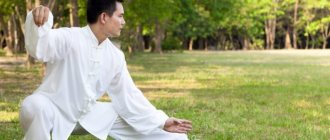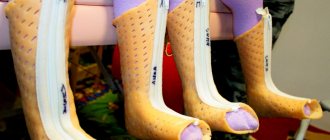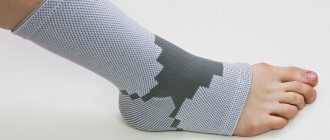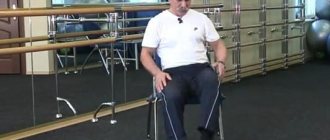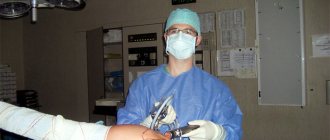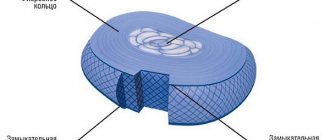Author of the article: Yachnaya Alina, oncologist surgeon, higher medical education with a degree in General Medicine.
Article publication date: 01/25/2013
Article updated date: 12/22/2020
Osteochondrosis is a complex degenerative disorder of joint cartilage. It can develop in virtually any joint, but the discs between the vertebrae are most commonly affected. Depending on the location, lumbar, thoracic and cervical types of osteochondrosis are distinguished. Most often, constant static loads lead to cervical osteochondrosis. To prevent the occurrence of this disease and to strengthen the muscles that hold the intervertebral discs, exercises are prescribed for cervical osteochondrosis. Let's take a closer look at the sets of exercises for osteochondrosis.
Features of chondrosis
Chondrosis is a pathological process that occurs in certain parts of the spine, namely, in the intervertebral discs . The early stage of the disease passes without symptoms, the same is observed at later stages.
With chondrosis, there is a deterioration in the nutrition of the intervertebral disc, and therefore it becomes deformed
It is most common in older people 55 years of age and older, but there are cases of detection in young and middle age.
Basic elimination methods
Conservative methods are used to treat the initial stage of chondrosis:
- physiotherapy;
- medicines;
- products and means that fix the spine;
- physiotherapeutic products.
At a later stage, when the structure of the spine is seriously damaged, surgical treatment is used.
Used as drugs:
- analgesics;
- antispasmodics;
- chondroprotectors;
- anti-inflammatory agents;
- vitamins.
Methods for treating lumbar osteochondrosis
In the fight against osteochondrosis, a competent integrated approach is used.
The main goals of therapy are:
- restoration of blood circulation;
- elimination of muscle spasms;
- relieving inflammation and swelling;
- pain relief;
- eliminating the cause of the disease.
Therapy for lumbar osteochondrosis includes the following methods::
| Treatment with medications | Helps relieve pain and reduce inflammation |
| Physiotherapeutic procedures | affect special points responsible for blood supply and nutrition to the damaged area |
| Manual therapy and massage | relax and strengthen muscles, improve blood circulation, restore the affected vertebra |
| Physiotherapy | trains the muscle corset, increases the flexibility of the spinal column, slows down the destruction process |
| Surgery | used to eliminate the cause of pain and stabilize the spine |
| ethnoscience | stimulates blood circulation, reduces malaise, prevents exacerbation of the disease |
You can learn more about the use of therapeutic exercises for osteochondrosis in the following articles:
- Physical therapy for osteochondrosis in the cervical back
- Compare physical therapy with traditional treatment of thoracic osteochondrosis on the page
- To find out how Shishonin’s gymnastics is useful for the neck with osteochondrosis, go here
- How to properly perform exercises with a stick to prevent osteochondrosis can be read here
Gymnastics for chondrosis
Advantages of the method
With the help of special exercises, the patient gets rid of pain, restores blood circulation in the affected part of the spine and the healthy position of the vertebrae, and strengthens the muscles.
Check out the benefits of exercise therapy for chondrosis. Regular exercise has a positive effect on the body, which consists of:
- reducing stress on the vertebrae;
- increasing the space between the vertebrae, which prevents pinching of the nerve roots;
- normalization of metabolic processes;
- eliminating muscle spasm in the sore back;
- restoring normal nutrition to the brain.
In addition to eliminating the symptoms of chondrosis, physical therapy can also:
- correct posture;
- strengthen the muscles of the whole body;
- relieve the spine and the entire musculoskeletal system;
- reduce weight if you have extra pounds.
When to do exercise therapy
Exercises are performed during the absence of symptoms, that is, during the period of remission of the pathology . During classes, all movements must be performed smoothly and slowly. You should be attentive to your well-being: if the exercises cause discomfort, you should stop training immediately. During an exacerbation of symptoms, you need to abandon exercise therapy, since this can not only increase the pain, but also harm your back.
Contraindications
Loads are abandoned when:
- exacerbation of the disease;
- pathologies of the vestibular apparatus;
- high blood pressure;
- cardiac arrhythmia;
- early recovery period after surgery;
- neurological abnormalities in which coordination of movements is impaired;
- increased intraocular pressure;
- myopia.
There is no need to exercise immediately after eating or on an empty stomach, if you are overtired. You should not expect an immediate effect, but long-term and correct movements performed regularly will bring significant improvement.
General requirements for classes
Lumbar osteochondrosis is rarely accompanied by acute inflammation of soft tissues, so training begins immediately after severe pain has been relieved. The neurologist refers the patient to a physical therapy doctor, who will draw up a schedule of classes and a set of exercises taking into account physical fitness, the severity of the pathology, and the number of complications that have developed.
Restoration of all functions of spinal structures is also carried out by specialists in rehabilitation centers. The following requirements apply to the classes:
- training should be done daily, not occasionally. This is the only way to achieve the maximum therapeutic effect within several months;
- You should not stop exercising after symptoms disappear or their severity decreases. Osteochondrosis is still a completely incurable pathology, so its therapy is carried out throughout life;
- You should start training an hour after eating;
- Exercises should be performed in clothes made of breathable, moisture-absorbing materials;
- It is necessary to combine therapeutic exercises with massage, physiotherapeutic measures, and a visit to the swimming pool.
During lumbar osteochondrosis, exacerbations are replaced by remissions. Each stage has its own set of exercises. During relapses, you should not make intense movements that can provoke pain. But when remission is achieved, a slight increase in loads is very useful for building up the muscles of the lower back.
Types of exercise therapy for chondrosis
There are treatment complexes for the following areas: cervical; chest; lumbar _
Physical education varies by type. There are such exercises: static; dynamic .
The dynamic type involves relaxing and contracting the muscles, while static exercises involve tensing the muscles and holding the body in a certain position for some time.
Do you want to know more about the traditional treatment of chondrosis? Read the following articles:
- Find out what tablets are used for spinal chondrosis by following this link
- You can read about the features and principles of treating chondrosis with ointments on the page
- How is massage done for back chondrosis in the cervical, thoracic and lumbar regions?
- Indications for the use of drugs in the form of injections for chondrosis
Achieved effect
When drawing up a therapeutic regimen, neurologists explain to the patient the meaning of regular physical education and gymnastics. Lumbar osteochondrosis cannot be cured with pharmacological drugs. No medications have yet been synthesized whose use would help restore damaged discs and vertebrae. Therefore, the goal of therapy is to improve blood circulation in the lumbar region. Regular training is the best way to cope with this task. What effect should be expected after several months of daily exercise:
- together with the blood, a sufficient amount of nutrients is supplied to the vertebral structures for their regeneration;
- the muscles of the entire back are strengthened, which helps stabilize the discs and vertebrae, preventing their displacement, compression of the spinal roots and blood vessels;
- improving lymphatic drainage and blood circulation stimulates the restoration of soft tissues, ligaments, muscles, tendons, and in case of osteochondrosis of 1st degree of severity, cartilage.
Stiffness in the lower back gradually disappears, posture and gait are corrected, and the loads that arise when walking are distributed evenly to all parts of the spine.
Technique and features of performing exercises for chondrosis
As a rule, the complex is selected for a specific patient individually by a doctor . For the neck, perform head tilts, turns, or muscle stretches. If it is difficult for the patient to perform them while standing, they can be done while sitting. For the chest area, use trunk bends, turns and bends, shoulder exercises, circular movements of the shoulders, lifting them and final stretching exercises. For lumbar chondrosis, bending and stretching, abdominal movements, and arching are also performed.
Cervical region
Did you know that...
Next fact
In order not to overstrain this department, other muscles are involved in exercise therapy.
Pay attention to the list of exercises for the neck
It is worth using such exercises:
- Perform circular movements with your elbows in different directions 4 times. Repeat 2-4 times.
- Lie on your back and stretch out lengthwise. Raise your head and hold it in this position for about 5 seconds.
- Stand up straight and take turns reaching your arms toward the ceiling. Perform 7 times.
- Lie on the floor, rest the back of your head on the floor, count to 4, relax. Repeat this cycle 5 times.
- In a lying position, raise your head, turn it to the right, wait 3 seconds, relax. Repeat the same on the other side. Do the exercise 5 times.
- Stand up, hands on your belt. Bend your knees, inhale, straighten and exhale. Repeat 5 times.
- Lie on the floor, stretch out, arms along your body. Press your shoulder blades toward the floor, bringing them together. Hold for 4 seconds, relax. Repeat 5 times.
- Stand straight, look ahead. Slowly tilt your head to the right towards your shoulder, then to the left. The head seems to be resting on the shoulder. Repeat for each side 5 times.
- In the same position, tilt your head back. This must be done extremely carefully and slowly. Repeat 5 times.
- Without changing position, lower your head to your neck as low as possible, but as far as stretching allows. Repeat 5 times.
Exercises for the cervical spine are recommended in the morning and throughout the day. You should avoid rotating your neck, as this can injure your vertebrae. .
Thoracic region
Cat - the most effective exercise for the thoracic region
The following exercises are recommended:
- Lie on your back, bend your knees. Using your hands, pull your legs towards your chest and slightly lift your lower back off the floor. Hold for 5 seconds, relax. 2 repetitions are enough.
- The same position, arms extended behind the head, body extended. The left arm and right leg are pulled towards each other, and the spine is stretched. Pause, change arms and legs. The exercise is performed slowly, 3 repetitions are intended on each side.
- Roll over onto your stomach, arms by your sides. Raise your arms and head, tensing your muscles. Hold for 3 seconds, relax. Repeat 5 times.
- Return to the supine position. Hands behind head, body stretching. Raise your legs and try to touch your toes to the floor behind your head. Make sure your knees don't bend. Repeat 5 times.
- Roll over onto your right side, bend your knees. One leg is lifted up and fixed for 3 seconds. Then repeat on your left side. You want your hips to be as abducted as possible. Do it slowly.
- Go to all fours. Arch your back as you inhale, bend it as you exhale. Do it slowly 5 times.
- Get on your knees. Raise your arms up as you inhale, lower them as you exhale. The pace should be average. Try to move your hands as far as possible. Repeat 3 times.
- Return to all fours. Raise your head up and arch your back. Lower your head to your chest and arch your back. 3 repetitions are enough.
- Sit on a chair, lean your shoulder blades on the back. Slowly bend back, leaning on the chair.
- Without getting up, place your hands between your knees. As you inhale, bend your torso, and as you exhale, return to the starting position.
- Sit up straight. Inhale - bend, exhale - straighten. Breathing should be calm and even.
Video: “Set of exercises for osteochondrosis”
Lumbar
Hyperextension best strengthens the longitudinal muscles of the back
Exercises for the lower back with chondrosis should be carried out in a gentle manner . Here are some examples:
- Lie down and stretch out. As you inhale, arms up, as you exhale, arms down. Repeat 5 times.
- Without changing position, rotate your feet and hands at the same time. Repeat 10 times.
- Rotate your feet only 6 times in each direction. 2 repetitions are enough.
- Lying down, pull your knees to your chest one at a time. Do it 7 times.
- Without changing position, take turns moving your right arm and leg, then your left arm and leg. Enough 5 times on each side.
- In a lying position, place your hands behind your head in a lock. At the same time as you raise your head, pull your socks towards you. Do it 8 times.
- Lying down, bend your knees and place them shoulder-width apart. The right knee touches the left chest and vice versa. Repeat 5 times.
- Repeat the movements as when riding a bicycle. 5 times is enough.
- Place your hand on your stomach. Take a deep breath and exhale slowly. Repeat 4 times.
- Move your right arm up and your left arm along your body. Change the position of the limbs one at a time.
- Stand up, spread your legs shoulder-width apart, arms to the sides. Bend over and reach your right heel with your left hand and vice versa. 5 repetitions are enough.
- Without changing position, pull your knees to your chest one by one, helping yourself with your hands. Repeat 5 times.
- Extend and bend your feet. Repeat 10 times.
- Lie on your side and simultaneously raise your arm and leg. Repeat 5 times.
- Without changing position, pull your knee to your chest 5 times.
- Swing your leg back and forth 5 times. Then turn on the other side and do the same.
- Sitting on all fours, take turns moving your straight arms in front of you. Repeat 5 times.
- Without changing position, pull your knees to your chest. 5 times is enough.
Video: “The importance of exercise therapy and technique for osteochondrosis”
Contraindications for carrying out
You should not start exercising if you feel generally unwell, as this may provoke another relapse of lumbar osteochondrosis. It is strictly forbidden to train if you have ARVI, influenza, intestinal or urogenital infections. Contraindications to exercise include an increase or decrease in blood pressure, bradycardia, tachycardia, impaired coordination of movements, nausea, sensations of bloating, distension of the abdomen.




